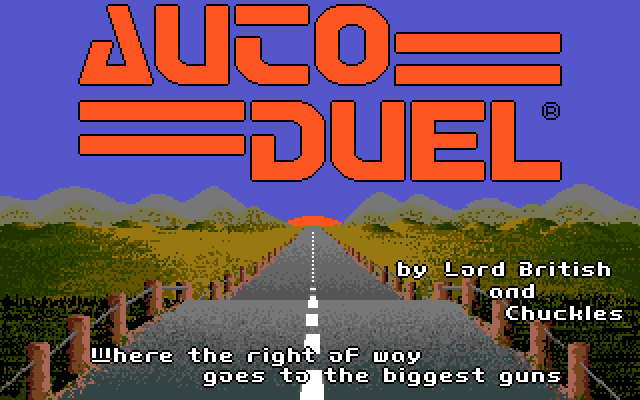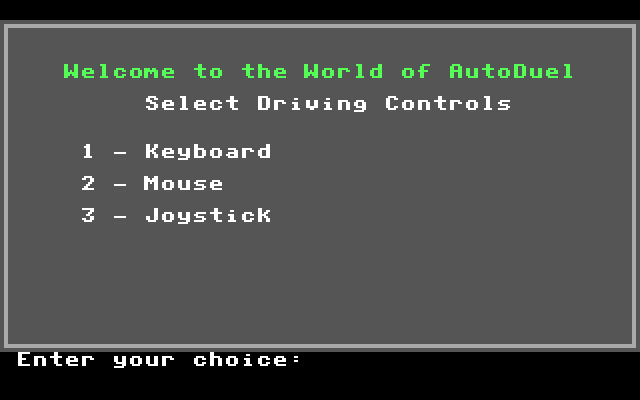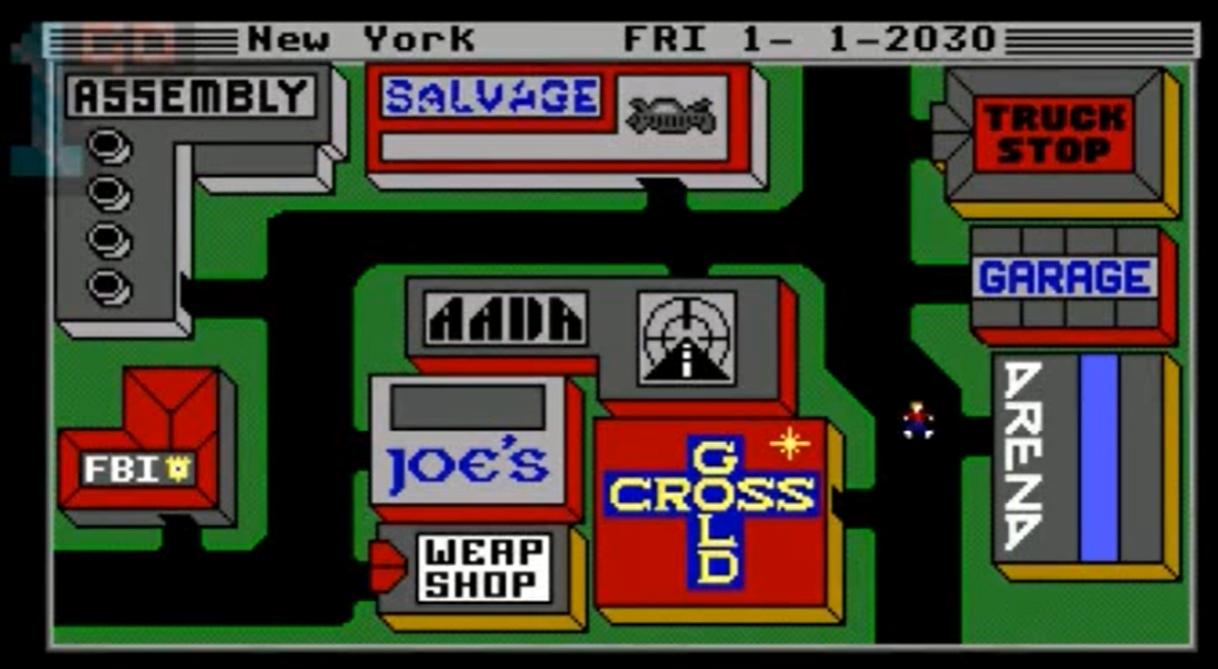All That Blitters: Autoduel

The first time I played Car Wars, the board game developed by Steve Jackson, was in 1985. In seventh grade, I crossed paths with a small group of boys who spent their recess periods holed up inside an empty classroom playing board games. I spent a lot of recesses with those guys playing Risk, Stratego, Axis and Allies, and Chess. (And later, Dungeons and Dragons.) It was during one of those post-lunch gaming sessions that I was introduced to Car Wars.
At its core, Car Wars is a lot like Dungeons and Dragons with all the adventure removed, leaving only the combat. Players begin by spending a predetermined amount of money on a car, equipping their car with weapons, armor, and upgrades, and then entering an arena with the sole purpose of destroying everyone else’s car. The version we played used tiny paper cutouts to represent each car on an oval-shaped track. Rolled dice determined the outcome of our attacks and the success of our four-wheeled maneuvers. Additional add-on modules introduced new vehicles and scenarios into the vehicular fray, although our combat took place on a laminated sheet of graph paper. With a few lucky rolls of the dice I held my own on the first lap, and was subsequently burned to a crisp during the second lap by an 18 wheeler with three flamethrowers mounted to its trailer. I will neither confirm nor deny that our gaming session was enhanced through the addition of scratch and sniff stickers that smelled like burnt rubber and gasoline.
In the earliest days of computer software, lots games were simply inferior ports of arcade games. Before long, developers began to embrace the features that computers did better than arcade games. Text adventures, point-and-click adventures, and RPGs thrived on home computers, and as computer games grew into their own and budgets grew, developers began using licensed properties in their games. Between the relative popularity of Car Wars and the success of films like Mad Max and Deathrace 2000, it was only a matter of time before someone brought a post-apocalyptic car game to home computer screens.
That company would be Origin, who, in 1985, brought Steve Jackson’s Car Wars to home computers under the name Autoduel. It’s not entirely clear why the computer game was not also titled Car Wars, although a different but identically titled game previously released on the TI-99/4A may have been the reason. Despite the changed name, there was little confusion that Autoduel was the official version of Car Wars. Jackson’s board game refers to the sport of “autodueling,” and both games share the same tagline: “Where the right of way goes to the biggest guns.”
Origin Systems, founded by Richard Garriott, already had experience with computer-based role playing games before tackling Car Wars. Prior to Autoduel’s 8-bit debut, Origin had already released Ultima 1-4, along with Caverns of Callisto and Moebius. Origin was as well-suited as anyone to translate Jackson’s board game to the realm of home computers.
In 1985, Origin released Autoduel for several 8-bit computers. Two years later, the company began porting the game to multiple 16-bit platforms, including the Macintosh, the Atari ST, MS-DOS, and finally, the Amiga. Origin could have used this as an opportunity to clean up issues from the original release, adjust the game’s initial difficulty, and upgrade the basic sound and graphics found on the original versions. Instead, they chose to do none of those things. Other than very minor differences in sound and graphics, every port of Autoduel is identical.
The Amiga version of Autoduel begins like all the others, with a picture of an open road displayed along with a fairly nondescript ditty. You would think that in a game about cars and guns, the title screen would show at least one of those things. After the song ends, players are dropped into a series of gray screens covered by white text, where players can create, load, or delete drivers. New drivers start with $2,000, no prestige or armor, and 50 skill points that can be distributed between three abilities (health, marksmanship, and mechanical ability).

From there, new characters are Immediately dropped — on foot — in New York. This is as good a place as any to talk about the map’s graphics, which appear to be identical to the IBM PC’s version. The grass is a single shade of green and the buildings are combinations of red, gray, and mustard yellow with minor highlights of blue and white. The driving sequences on the Amiga seem to leverage the color palette from the Apple II. 1988 was the same year IK+, Elite, Pac-Mania and Rocket Ranger were released for the Amiga. CGA-quality graphics on the Amiga look shockingly dated, especially on a system known for graphical excellence. It’s more than embarrassing; on the Amiga, it’s a crime.
New York City offers players ten unique locations to visit, although most of them won’t do you much good until you own a car. Also, frustratingly, each building has a particularly narrow entryway that you must guide your avatar into, which is a million times more difficult to perform than it should be. If your little person is one pixel off, he or she cannot enter a building. I spent ten minutes trying to get my tiny man to enter buildings only to be notified they were closed for the day. Whoever decided the game’s menu needed to be this difficult to navigate should be subjected to the business end of a car-mounted flamethrower. “Walking onto a sidewalk” should not be a point of frustration.

Players won’t get far without a set of wheels, a process gear heads are sure to love as they pick the body style, chassis, suspension, tires, weapons, and armor their vehicle will possess. Players begin with $2,000 and the cheapest vehicle costs $1,000. After adding armor (a necessity if you want to last longer than 30 seconds), you won’t have enough money left to purchase everything you’ll need in the game, and that’s kind of the point. Autoduel is all about hustling, scrapping, and occasionally gambling in order to survive.
Other buildings around the city (all conveniently located on a single screen) include an FBI station and Joe’s Bar (where paying gigs can be obtained), a salvage shop where scavenged parts can be turned into cash, a Truck Stop for resting, and the Cross Gold Health Care center. The best way to protect your goods is to clone yourself at the center, but get ready to pay. Cloning your character (making a copy/backup) costs $5,000, which is more money than most casual players may ever see.
The real action begins in the Arena, where players can burn rubber and fire weapons at AI opponents. It’s a good place to learn how your car handles, and how well — or poorly — your armor repels bullets. Do well and you can earn enough money to upgrade your car. Success in the arena leads to more events with higher stakes and financial rewards.
Once you’ve milked New York City for all it’s worth, it’s time to head to the next town. A physical map included with the game shows players how cities are connected. The roads between the towns are filled with marauders who will test your car’s armor. Each time I entered a state highway, I spent five minutes driving alone before encountering an enemy and being killed in less than two seconds. If you’re not a fan of insta-death, you might want to play Autoduel on an emulator and use save states, because just like the real world, in Autoduel dead means dead.

There is an end to the game, although it’s highly unlikely most players will ever see it. The ultimate goal of defeating Mr. Big cannot be achieved without hours (days? weeks?) of grinding. You’ll need money, prestige, patience, and time to work your way up in the game, keeping in mind that a single motorcycle with an uzi mounted to its front fender can end your progress faster than Mad Max’s Interceptor in the quarter mile. Even with save states or other cheats (like copying your player disk mid-game), you will most likely run out of patience long before the bad guys run out of ammo.
Autoduel is an interesting game. The RPG-elements are likely to bore and overwhelm action gamers, and RPG-fans won’t enjoy the deadly combat sequences. Even if the two halves worked together, which they mostly don’t, they don’t make a lot of sense on the Amiga, a machine known for its graphics and sound. Loyal defenders of the game remain in love with the game’s concept, but unfortunately the concept is better than the game itself.
